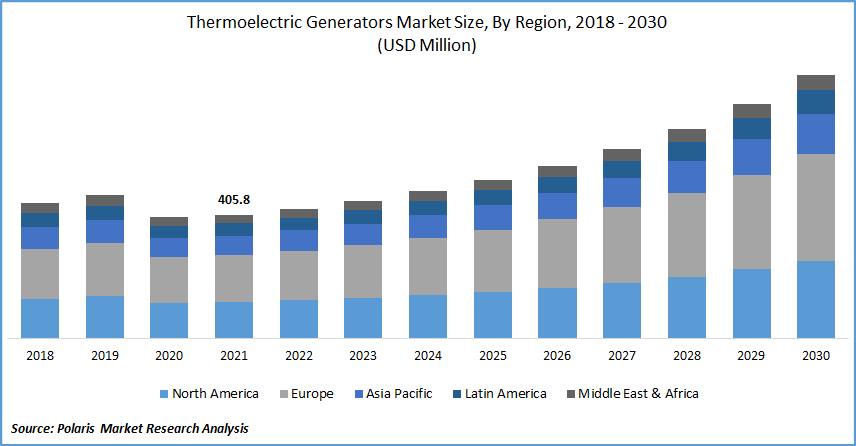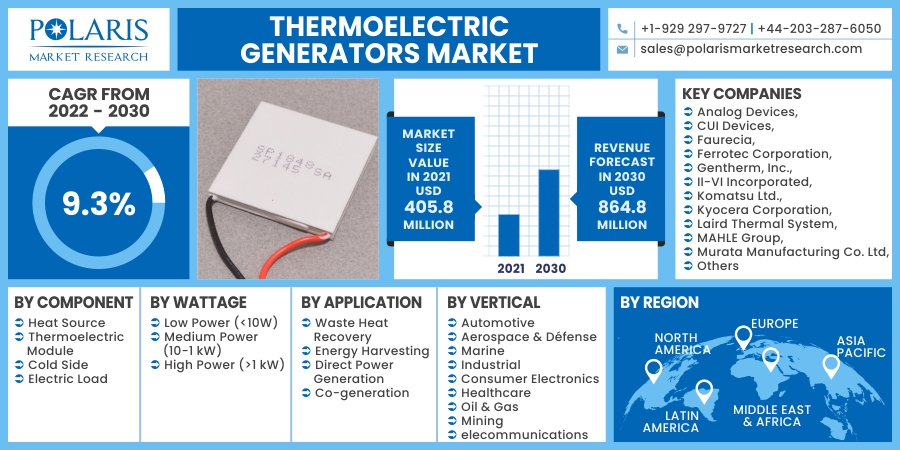
Thermoelectric Generators Market Share, Size, Trends, Industry Analysis Report
By Components (Heat Source, Thermoelectric Module, Cold Side, Electric Load), By Wattage, By Application, By Vertical; By Region; Segment Forecast, 2022 - 2030
- Published Date:May-2022
- Pages: 116
- Format: PDF
- Report ID: PM2377
- Base Year: 2021
- Historical Data: 2018 - 2020
Report Outlook
The global thermoelectric generators market was valued at USD 405.8 million in 2021 and is expected to grow at a CAGR of 9.3% during the forecast period. The increasing demand for waste heat recovery systems, coupled with the rising adoption of renewable energy sources, are the major factors that are anticipated to drive the thermoelectric generator industry demand around the world.
 Know more about this report: request for sample pages
Know more about this report: request for sample pages
Thermoelectric generators are durable and highly reliable, as well as they are environmentally friendly that do not include chemical products, which, in turn, is fostering the demand for thermoelectric generators market across various end-use verticals. Furthermore, governments are also executing several stringent norms for reducing carbon emissions, and an increasing number of initiatives for controlling greenhouse emissions are also acting as catalyzing factors for global thermoelectric generators industry growth.
The COVID-19 outbreak affects all industries in the global economy owing to the lockdown restrictions imposed by governments, which have negatively impacted the capital investments in various sectors. The thermoelectric generators industry has exhibited a considerable downfall in this period. This is primarily due to the reducing demand for consumer electronics and decreasing demand in the automotive, aerospace, industrial, and many other applications.
The unavailability of raw materials and restricted cash inflow substantially affects the production activity that hinders the manufacturing activities. For instance, Komatsu Ltd. - the leading global supplier of precise thermal control systems as per the modules, accounted for enormously unsteady demand during this period. However, the gradual opening of lockdown and increasing industrialization activity are anticipated to fuel the thermoelectric generators market demand in the impending years.
Industry Dynamics
Growth Drivers
The increasing number of research & development activities for upgrading the performance of thermoelectric generators is one of the key driving factors for market growth. The usage of conventional technologies and the low efficiency of TEGs are hampering the development of TEGs. Accordingly, manufacturers and researchers are working to conquer the three major challenges: improving ZT, enhancing the operating range of materials for operating with higher temperature differences, and discovering cost-effective materials to neutralize the negative impact of low competence of the TEGs.
Thereby, in the present scenario, researchers are more emphasize the industrialization of new thermoelectric generator materials that provide better proficiency. The synthesizing of materials like Cu2?x Se and PbTe 0.7 S 0.3, with a figure of merit ZT> 2, offers the greatest ZT under a certain temperature range. Hence, to attain maximum benefits, researchers are focusing on fabricating and designing thermocouples with fragmented materials to withstand the needed heat source temperature while maintaining the highest ZT. Therefore, these factors are likely to propel the global thermoelectric generator industry demand in the approaching years.

Know more about this report: request for sample pages
Report Segmentation
The market is primarily segmented on the basis of component, wattage, application, vertical, and region.
|
By Component |
By Wattage |
By Application |
By Vertical |
By Region |
|
|
|
|
|
Know more about this report: request for sample pages
Insight by Component
The heat Source segment is recorded to hold the largest revenue share. The thermoelectric generators are also commonly known as Seebeck generators, which transfer heat flux directly into electricity by applying the Seebeck effect. The heat source segment has huge traction in the automotive sector as it converts heat flux into electrical energy and reduces carbon emissions from vehicles.
Various car manufacturing companies, such as BMW, Ford, Volvo, and Volkswagen, entered into taking various initiatives to develop thermoelectric generators waste heat recovery systems for fuel economy purposes. Therefore, these factors act as a significant factor for the segment demand worldwide. The thermoelectric module segment is projected to witness the highest growth rate in the forecasting years.
The growing adoption of efficient materials for manufacturing this module is fostering the segment demand. This helps in producing power through the help of a thermocouple. This module generates power when a temperature difference pertains to both sides and also helps in improving efficiency. Additionally, this module has extremely conductive graphite sheets on both sides of the ceramic plates that present low thermal resistance and gaining popularity in both high & low-temperature applications. Hence, these factors are fueling the segment growth in the near future.
Geographic Overview
North America accounted for the largest revenue share in the global market. The increasing number of technological developments in North America coupled with the rising need for generators by aerospace, automotive, healthcare, and many other segments are anticipated to accelerate the market demand.
Furthermore, increasing competition between competitors, as well as the presence of the leading market players, is also presenting various growth opportunities for market development. Additionally, surging demand for generators by automotive industries as they are more inclined to improve fuel efficiency, along with rapid industrialization in the region, which, in turn, accelerates the growth of the market demand in the approaching years.
Moreover, the European market is projected to exhibit the highest CAGR over the forecasting years. The thriving growth of automotive industries, as well as the presence of a huge consumer base across the region, is stimulating the market demand across the region. In addition, the execution of the stringent regulations related to C02 emissions from vehicles and an increasing number of initiatives by various public & private corporations to reduce carbon emission is also accelerating the market growth.
Moreover, Europe is the leading global region, which is highly inclined towards the usage of renewable energy. For instance, as per the Eurostat, there were nearly 17% of the EU heating, and cooling sector, 26% of the EU's electricity, as well as 6% of EU transport energy is obtained from renewable energy sources. Also, Europe invests considerably in total renewable energy because of surging demand for renewable electrical energy in various end-use verticals and rising adoption in the power sector and the. Therefore, this factor is anticipated to fuel the demand for the thermoelectric generators market in the region.
Competitive Insight
Some of the major players operating in the global market include Analog Devices, CUI Devices, Faurecia, Ferrotec Corporation, Gentherm, Inc., II-VI Incorporated, Komatsu Ltd., Kyocera Corporation, Laird Thermal System, MAHLE Group, Murata Manufacturing Co. Ltd, Tec Microsystems, Tecteg, Toshiba Corporation, and Yamaha Corporation.
Thermoelectric Generators Market Report Scope
|
Report Attributes |
Details |
|
Market size value in 2021 |
USD 405.8 Million |
|
Revenue forecast in 2030 |
USD 864.8 Million |
|
CAGR |
9.3% from 2022 - 2030 |
|
Base year |
2021 |
|
Historical data |
2018 - 2020 |
|
Forecast period |
2022 - 2030 |
|
Quantitative units |
Revenue in USD Million/Billion and CAGR from 2022 to 2030 |
|
Segments covered |
By Component, By Wattage, By Application, By Vertical, By Region |
|
Regional scope |
North America, Europe, Asia Pacific, Latin America, Middle East & Africa |
|
Key companies |
Analog Devices, CUI Devices, Faurecia, Ferrotec Corporation, Gentherm, Inc., II-VI Incorporated, Komatsu Ltd., Kyocera Corporation, Laird Thermal System, MAHLE Group, Murata Manufacturing Co. Ltd, Tec Microsystems, Tecteg, Toshiba Corporation, and Yamaha Corporation |
